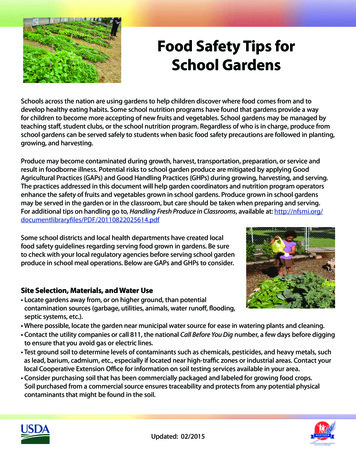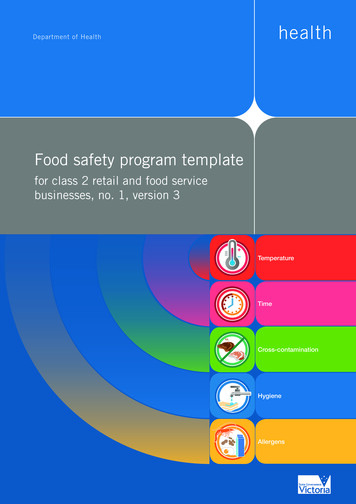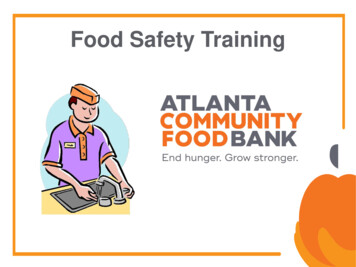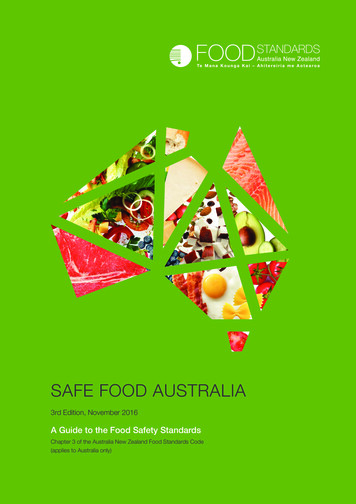
Transcription
Food Safety Tips forSchool GardensSchools across the nation are using gardens to help children discover where food comes from and todevelop healthy eating habits. Some school nutrition programs have found that gardens provide a wayfor children to become more accepting of new fruits and vegetables. School gardens may be managed byteaching staff, student clubs, or the school nutrition program. Regardless of who is in charge, produce fromschool gardens can be served safely to students when basic food safety precautions are followed in planting,growing, and harvesting.Produce may become contaminated during growth, harvest, transportation, preparation, or service andresult in foodborne illness. Potential risks to school garden produce are mitigated by applying GoodAgricultural Practices (GAPs) and Good Handling Practices (GHPs) during growing, harvesting, and serving.The practices addressed in this document will help garden coordinators and nutrition program operatorsenhance the safety of fruits and vegetables grown in school gardens. Produce grown in school gardensmay be served in the garden or in the classroom, but care should be taken when preparing and serving.For additional tips on handling go to, Handling Fresh Produce in Classrooms, available at: 025614.pdfSome school districts and local health departments have created localfood safety guidelines regarding serving food grown in gardens. Be sureto check with your local regulatory agencies before serving school gardenproduce in school meal operations. Below are GAPs and GHPs to consider.Site Selection, Materials, and Water Use Locate gardens away from, or on higher ground, than potentialcontamination sources (garbage, utilities, animals, water runoff, flooding,septic systems, etc.). Where possible, locate the garden near municipal water source for ease in watering plants and cleaning. Contact the utility companies or call 811, the national Call Before You Dig number, a few days before diggingto ensure that you avoid gas or electric lines. Test ground soil to determine levels of contaminants such as chemicals, pesticides, and heavy metals, suchas lead, barium, cadmium, etc., especially if located near high-traffic zones or industrial areas. Contact yourlocal Cooperative Extension Office for information on soil testing services available in your area. Consider purchasing soil that has been commercially packaged and labeled for growing food crops.Soil purchased from a commercial source ensures traceability and protects from any potential physicalcontaminants that might be found in the soil.Updated: 02/2015National Food Service Management InstituteThe University of Mississippi
Food Safety Tips forSchool Gardens, continued Create reasonable barriers to keep animals (wild and domestic) away from the garden. Examples includefencing, electric fencing, or cages over produce items such as strawberries and leafy greens. In high-riskareas, consider fencing with a locked gate to prevent unauthorized individuals from gaining access to thearea in order to deter both intentional and unintentional contamination. Use non-toxic, non-leaching materials for raised-bed gardens, containers, stakes, or trellises. Pressuretreated wood, used tires, single use plastics, old railroad ties, etc. are not safe to use because of potentialcontamination. Select non-allergenic and non-toxic plants. Check with your local Cooperative Extension office if you needassistance determining plant safety or toxicity. Test all non-municipal water sources at least annually, including rain barrels, cisterns, ponds, streams,wells, etc. for potentially harmful organisms to make sure they meet the standards of the EnvironmentalProtection Agency (EPA). A good screening test is fecal coliform. For more information on potable water,go to the EPA website, available at: mation/pathogens.cfm, or contact your local Cooperative Extension Office for assistance. If not using potable, municipal water, maintain water testing records. Use clean, food grade containers to transport water. Do not allow students to drink from the watering hose; the water may be safe, but the hose may harborparasites.Chemical and Fertilizer Use Do not use any pesticides or herbicides due to potential health hazards to children. Check with your county Cooperative Extension Office for the best non-chemical method of control for localpest problems. Read and follow the manufacturer’s instructions when using fertilizer. Secure all fertilizers in a safe and locked location when not in use. Allow only adults to handle fertilizers. Check with your local health department about applicable Occupational Health and Safety Administration(OSHA) hazard communication requirements. Maintain Material Safety Data Sheets (MSDS) as required.More information is available at: http://www.osha.gov/dsg/hazcom/index.html. Maintain information on safe use and potential hazards that is available on product labels or from themanufacturer, for all fertilizers. Label the container with the common name of the fertilizer if transferring fertilizers into a dispensingcontainer. Never use a food container. Dispose of fertilizer and its containers according to the manufacturer’s instructions.Updated: 02/2015National Food Service Management InstituteThe University of Mississippi
Food Safety Tips forSchool Gardens, continuedCompost and Manure UseSchools are composting non-protein waste safely across the nation. That said, composting is a complexprocess that requires attention to specific procedures and conditions. This fact sheet is not comprehensive.Contact your local Cooperative Extension Office, or a composting expert for assistance. Avoid the use of raw manure. Composting raw manure for school gardens is not recommended due toincreased risk of contamination from pathogens that are not completely destroyed. Consider purchasing traceable, commercially prepared compost that is safe for use in edible gardens ifmanure-based compost is desired. Consider using worms to form vermicompost. Learn more about vermicomposting at: http://www.bae.ncsu.edu/topic/vermicomposting/ or watch the Vermiculture video available at: http://www.nfsmi.org/ResourceOverview.aspx?ID 513 Add only plant products, such as fresh fruit and vegetable culls from food production (apple and pear coresand vegetable trimmings), to a school compost pile. Other plant material, such as grass clippings, leaves,and twigs may be added to fruit and vegetable waste. Do not use animal products, animal waste, or any cafeteria waste that might have animal products incompost. Harmful pathogens might be introduced through animal products in compost material. Theseproducts must be properly managed to ensure their destruction. Always wear gloves when handling compost material. Locate the compost pile in a secure location away from potential contamination, such as garbage, waterrunoff, etc. Restrict access by animals as much as possible. Avoid contact with compost if you have a mold allergy.Growing and Harvesting ProduceA school garden provides an opportunity for children and volunteers tolearn about how to handle food safely. The following are some food safetytips to follow when growing and harvesting produce. Ensure that all persons, including staff, students, and volunteers receivebasic food and gardening safety training instructions. The followingtopics are recommended:u Handwashing and personal hygieneu Cleaning and sanitizing garden equipment and containers used tohold produceu Handling produce during harvest, washing, and transportationu Glove useUpdated: 02/2015National Food Service Management InstituteThe University of Mississippi
Food Safety Tips forSchool Gardens, continued Ensure that volunteers are covered by the school district insurance policy in the event of accident or injury. Obtain parental permission to work in the garden. It is recommended that the school garden permissionbe integrated into the general school paperwork at the beginning of the school year or use a waiver thatallows parents to opt out of garden activities, without requiring every student to have a slip. Permissionslips should explain the environment and activities in which the child will engage, and inform those withallergies to discuss further with the school nurse or healthcare provider. Do not allow anyone to work in the garden while sick, or until 24 hours after symptoms, such as vomiting ordiarrhea, have subsided. Consider developing alternative activities for these students such as worksheets orjournaling so that they do not come into contact with food, plants, or gardening supplies. Ensure that all harvesters wash hands thoroughly in warm, soapy water for at least 10 to 15 seconds, andthen rinse with potable water. Ensure that all open cuts or wounds on hands, arms, or legs are properlycovered prior to participating in the harvest. Hand washing should occur away from harvested produce. Require harvesters to wear closed-toed shoes to prevent cuts, stings, or other injuries. Consider using single-use disposable gloves when harvesting, or handling, fresh produce as an extraprecaution. Harvest the garden regularly and remove any rotten, damaged, potentially contaminated (bird droppings,animal nibbles) produce. Unusable produce may be added to the compost pile. Use cleaned and sanitized food grade containers, such as plastic bins or buckets, to hold harvestedproduce. Do not use garbage bags, garbage cans, and any container that originally held chemicals. Thesetypes of containers are made from materials that are not intended for food use. Clean harvesting tools, such as knives, scissors, etc., with soap and potable water immediately beforeharvesting.Using School Garden Produce in your School Meals Program Check with your local health department to determine if local policies exist. The USDA does not prohibit the use of school garden produce in school meals.The school nutrition director does have the responsibility to ensure that allproducts are safe. If the harvest from the school garden will be used in the school mealsprogram, the school garden coordinator should work cooperatively with theschool nutrition director to plan the use of harvest from the garden the gardeninto school menus. Items to discuss include what crops to grow, quantityneeded, estimated harvest time, food safety practices, product quality, deliverylogistics, etc.Updated: 02/2015National Food Service Management InstituteThe University of Mississippi
Food Safety Tips forSchool Gardens, continued School garden coordinators should be aware of food safety practices in the garden. This knowledge may bedocumented with certificates showing completion of training in GAPs and GHPs. Online and face-to-faceworkshops are available through Cooperative Extension. Use the information in this document as a guideto identify appropriate garden practices. See Best Practices: Handling Fresh Produce in Schools for guidelines on receiving, storage, preparation, andservice of fresh produce in schools. Reject produce that does not meet school nutrition program standards. Receive and inspect produce harvested from school gardens according to the same procedures used toinspect produce from the district’s distributors. Do not use any produce that has been noticeablycontaminated by animals or insects. Refrigerate garden produce immediately, unless theparticular item is normally held at room temperature. Store school garden produce separately from othersources of produce to maintain traceability. Document service of school garden produce onthe menu management/food production record.See Ensuring Traceability of Fresh Produce for moreinformation. Remember, growing your own food extends yourcontribution to the food chain and the responsibilityfor food safety that goes with it. It may be wise to checkwith your district’s insurance department to ensurethat you are covered in the event of a foodborne illnessclaim.Addressing Community DonationsMembers of your local community, or staff or faculty at your school(s) may want to donate produce grown inprivate or community gardens to your school meal programs or to your school(s). Although their intentionsare good, these products must be safe and of acceptable quality to serve in your school meals program.Acceptance of produce donations in the same condition as fruits and vegetables that you would normallyreceive is allowed by the USDA. Check all local and state health regulations regarding receiving community donations before you acceptthese products.Updated: 02/2015National Food Service Management InstituteThe University of Mississippi
Food Safety Tips forSchool Gardens, continued Provide information to community members about USDA policies and regulations for school mealprograms and state, local, and school district health requirements that you must follow. Address questionsin a positive manner. Communicate guidelines and expectations for growing and handling practices for any fruits or vegetablesused in your schools. Cooperative Extension, USDA Farm to School, and the National Food ServiceManagement Institute have resources available such as developed standard operating procedures forprocurement and checklist(s) to identify farm practices. Share this information with individuals or groupswho are interested in donating produce to your schools. Visit any gardens that supply produce to your school nutrition program to evaluate food safety practices.Discuss the practices in this document with gardeners. (See Verifying On-Farm Food Safety for additionalinformation) Only accept donations that are dropped off when a school nutrition staff member is present toreceive them. Identify source, date, and refrigerate immediately, unless room temperature storage isrecommended. Conduct a visual inspection of any vehicle used to transport produce to a school to assess whether it isclean. A vehicle should not be used to transport fresh produce if it is also used to transport live animals.Note: USDA’s Food and Nutrition Service has addressed questions regarding the operation of a schoolgarden in two memorandums:Memo SP 32-2009, dated July 29, 2009: s/2009/SP 32-2009 os.pdf.SP06-2015, dated November 12, P06-2015os.pdfWhile these policy memorandums outline how school food authorities may operate or purchase foodsfrom school gardens, school nutrition programs are not required to grow or use any produce fromschool gardens.Updated: 02/2015National Food Service Management InstituteThe University of Mississippi
ResourcesBucklin-Sporer, A. & Pringle, R.K. (2010). How to grow a school garden: A complete guide for parents andteachers. Portland, OR: Timber Press, Inc.Iowa State University Extension; Produce Food Safety for School and Community Gardens, available ary/National Food Service Management Institute; Verifying On-Farm Food Safety, available 0110822025822.pdfNational Food Service Management Institute; Ensuring Traceability of Fresh Produce, available 822025525.pdfNational Food Service Management Institute; Best Practices: Handling Fresh Produce in Schools, available 0100826093915.pdfNational Food Service Management Institute; Handling Fresh Produce in Classrooms, available 822025614.pdfNational Gardening Association, available at: www.kidgardening.orgNorth Carolina State University and North Carolina Cooperative Extension, Growing Safer Gardens, available at:www.growingsafergardens.comMcGrath, M. (2006). Book of Compost. New York: Sterling Publishing Company, Inc.School Composting: A manual for Connecticut schools, available at:http://www.ct.gov/deep/lib/deep/compost/compost pdf/schmanual.pdfState of California, Safety in the garden, available at: versity of Maryland Extension Grow It Healthy, available at: www.growit.umd.eduUniversity of Rhode Island, Connecticut, Maine, New Hampshire and Vermont. Garden to Table: Five steps to foodsafe fruit and vegetable home gardening, available ition/OPmemos/10/5stepsOM1010.pdfUSDA Food and Nutrition Service, School Garden Resources, available ources#sgThis project has been funded at least in part with Federal funds from the U.S. Department of Agriculture, Food and Nutrition Service through an agreement withthe National Food Service Management Institute at The University of Mississippi. The contents of this publication do not necessarily reflect the views or policies ofthe U.S. Department of Agriculture, nor does mention of trade names, commercial products, or organizations imply endorsement by the U.S. government.The University of Mississippi is an EEO/AA/TitleVI/Title IX/Section 504/ADA/ADEA Employer.In accordance with Federal law and U.S. Department of Agriculture policy, this institution is prohibited from discriminating on the basis of race, color, nationalorigin, sex, age, or disability.To file a complaint of discrimination, write USDA, Director, Office of Civil Rights; Room 326-W, Whitten Building, 1400 Independence Avenue, SW, Washington, DC20250-9410 or call (202) 720-5964 (voice and TDD). USDA is an equal opportunity provider and employer. 2015, National Food Service Management Institute, The University of MississippiExcept as provided below, you may freely use the text and information contained in this document for non-profit or educational use with no cost to the participantfor the training providing the following credit is included. These materials may not be incorporated into other websites or textbooks and may not be sold.The photographs and images in this document may be owned by third parties and used by The University of Mississippi under a licensing agreement. TheUniversity cannot, therefore, grant permission to use these images.Updated: 02/2015National Food Service Management InstituteThe University of Mississippi
National Food Service Management Institute The University of Mississippi pdated: School garden coordinators should be aware of food safety practices in the garden. This knowledge may be documented with certificates showing completion of training in GAPs and GHPs. Online and face-to-face workshops are available through Cooperative Extension.











